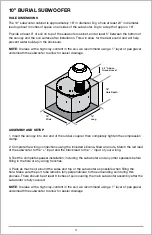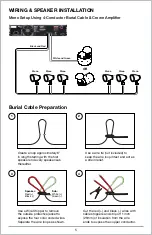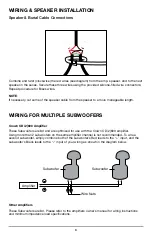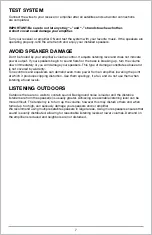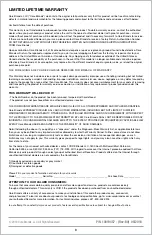
7
TEST SYSTEM
Connect the wires to your receiver or amplifier after all satellites and subwoofer connections
are completed.
IMPORTANT: Be sure to not let any stray “+” and “-” strands touch each other.
A short circuit could damage your amplifier.
Turn your receiver or amplifier ON and test the system with your favorite music. If the speakers are
operating properly, refill the wire trench and enjoy your installed speakers.
AVOID SPEAKER DAMAGE
Don’t be fooled by your amplifier’s volume control. It adjusts listening level and does not indicate
power output. If your speakers begin to sound harsh or the bass is breaking up, turn the volume
down immediately or you will damage your speakers. This type of damage constitutes abuse and
is not covered by warranty.
Tone controls and equalizers can demand even more power from an amplifier, lowering the point
at which it produces clipping distortion. Use them sparingly, if at all, and do not use them when
listening at loud levels.
LISTENING OUTDOORS
Outdoors there are no walls to contain sound. Background noise is louder and the distance
listeners are from the speaker(s) is usually greater. Achieving a reasonable listening level can be
more difficult. The tendency is to turn up the volume, however this may disturb others and when
turned up too high, can seriously damage your speakers and/or amplifier.
We recommend using multiple satellite speakers in larger areas. Using more speakers ensures that
sound is evenly distributed, allowing for reasonable listening levels at lower volumes. Demand on
the amplifier is reduced and neighbors are not disturbed.




